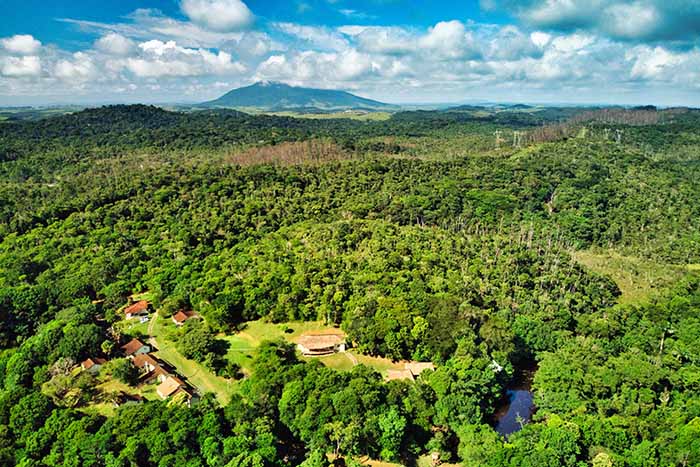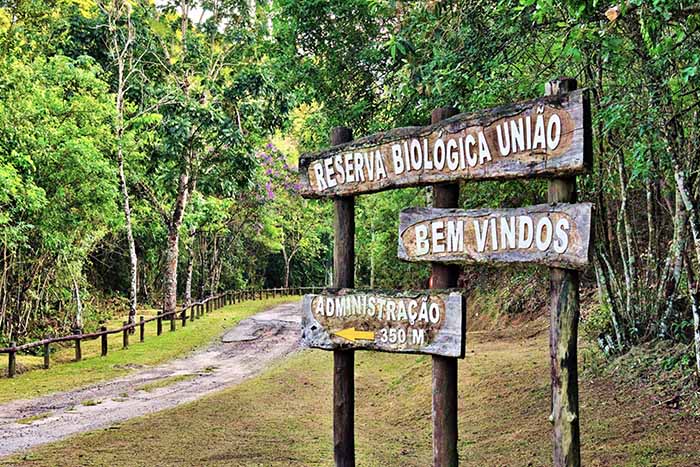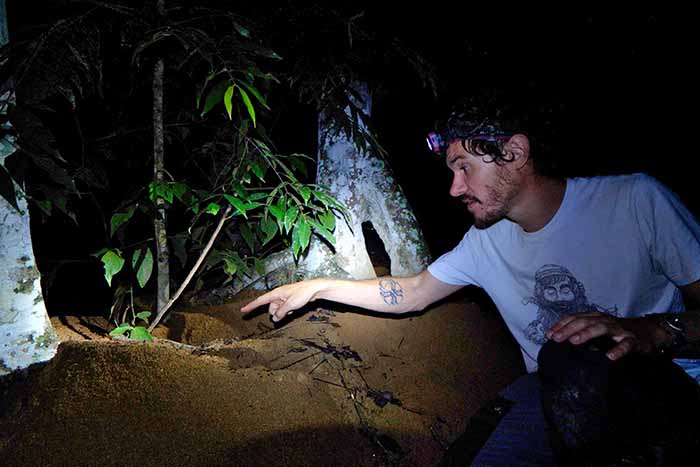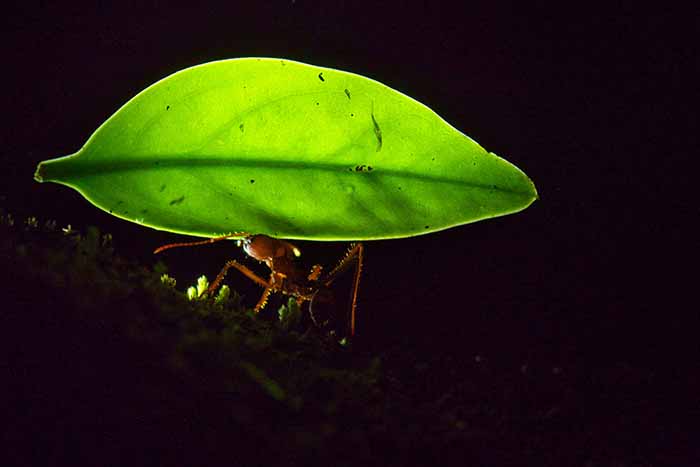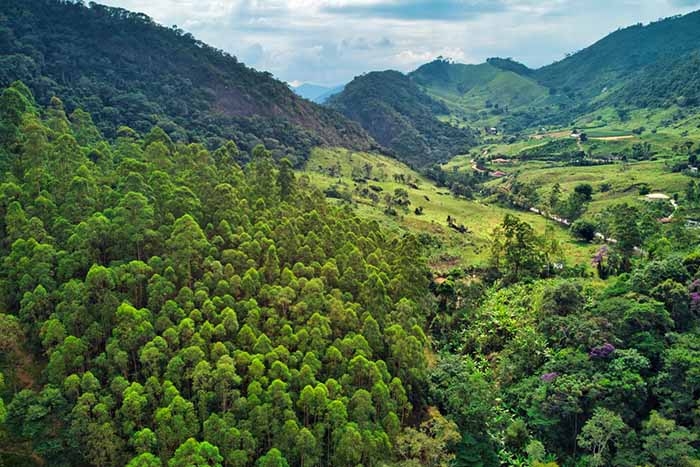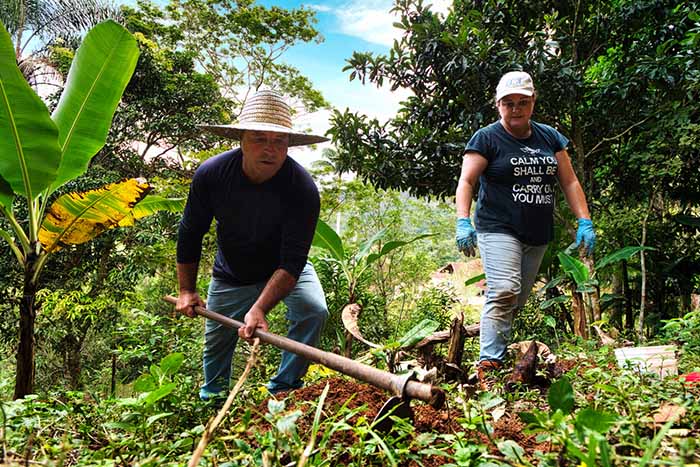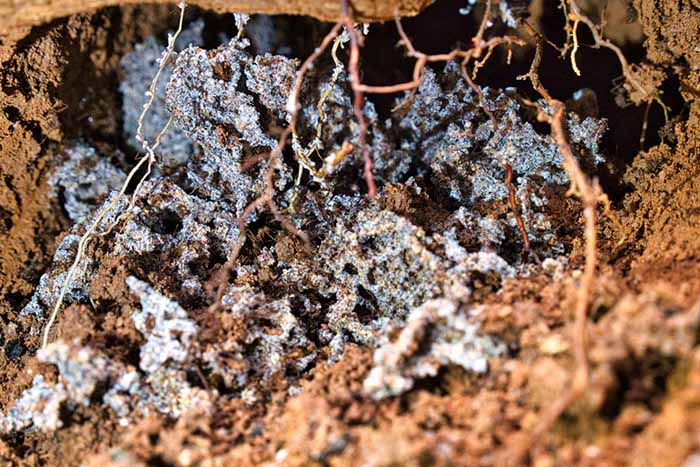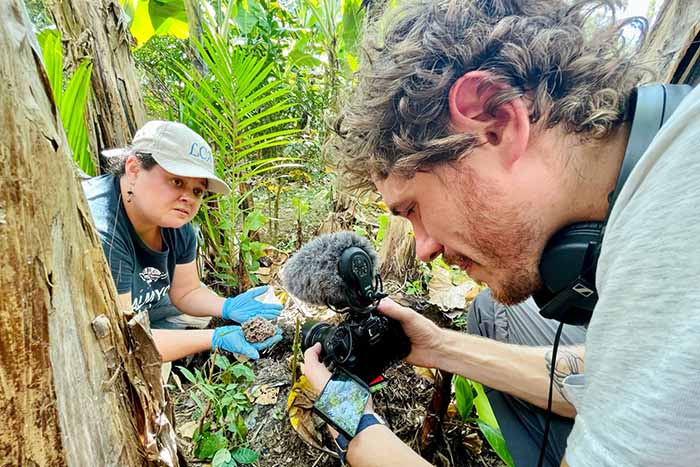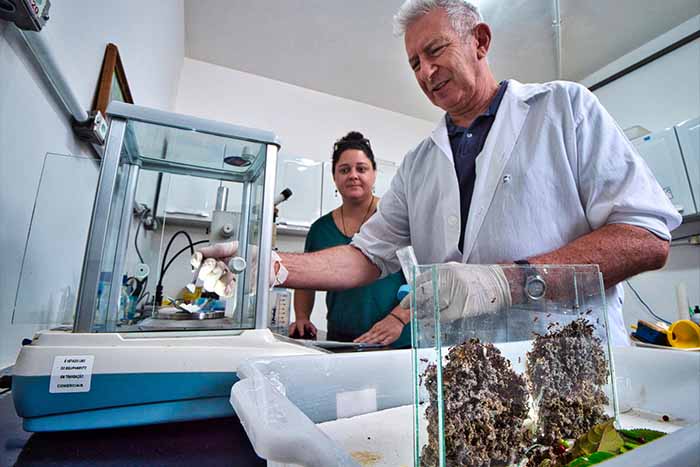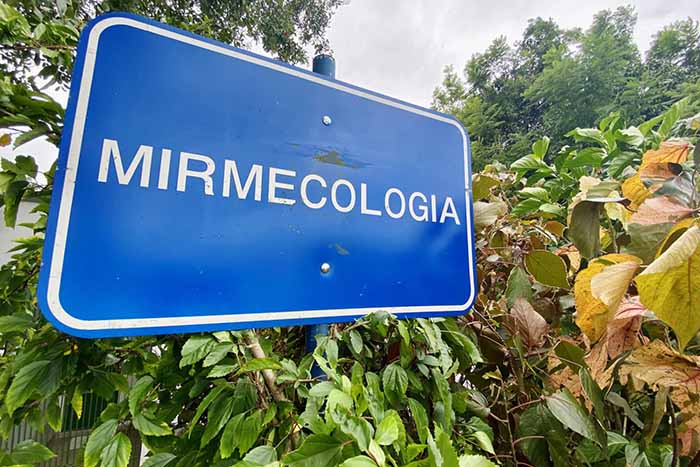Biodiversity Evolution⎢Brazil⎢2022
The Leaf-cutting ant
invasion
Partnering with Universidade Estadual do Norte Fluminense

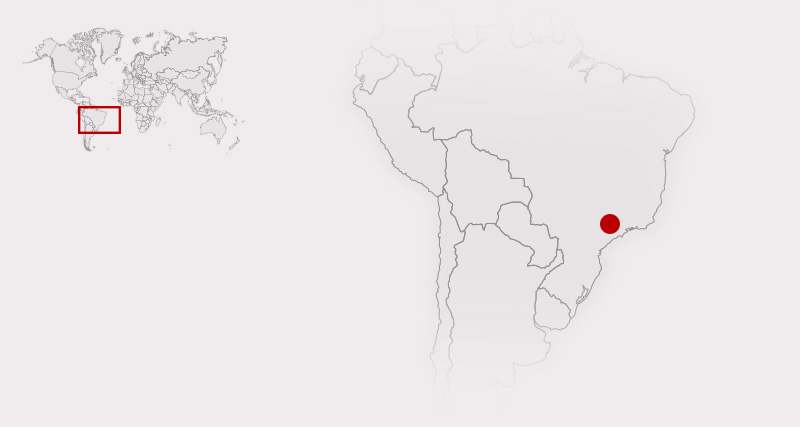
Leafcutter ants, exclusive residents of Tropical America, hold the distinction of being the world’s first agriculturalists, a practice dating back 50 million years! These industrious ants collect leaf fragments, which, when brought back to their anthills, serve as nourishment for a fungus, forming the foundation of their diet.
Since Darwin’s era, the population of leafcutter ants has consistently surged, posing a significant challenge for Brazilian farmers. In pursuit of ecological solutions for population control, we accompanied a team of specialists from the University of Norte Fluminense (UENF) on their research journey.
Days of Exploration
Associated Researchers
Photographs Taken
Hours of Footage

1832
A person, on first entering a tropical forest, is astonished at the labours of the ants: well-beaten paths branch off in every direction, on which an army of never-failing foragers may be seen, some going forth, and others returning, burdened with pieces of green leaf, often larger than their own bodies.
Following a pathway I entered a noble forest, and from a height of five or six hundred feet, one of those splendid views was presented, which are so common on every side of Rio. At this elevation the landscape attains its most brilliant tint; and every form, every shade, so completely surpasses in magnificence all that the European has ever beheld in his own country, that he knows not how to express his feelings.
– Charles Darwin, Voyage of the Beagle, 1832

2022
Over the centuries, the population of ants belonging to the Atta and Acromyrmex genera has experienced a substantial increase, owing to the advantages they gain from deforestation and monoculture practices.
This escalating presence of ants has become a major concern for farmers, as they now face combating a highly detrimental species.
Certain scientists are diligently seeking ecological control measures to minimize the need for extensive insecticide use. Nevertheless, long-term solutions appear to necessitate a shift away from intensive monoculture towards embracing polyculture or agroforestry practices, thereby promoting a more sustainable agricultural approach.

1832
A person, on first entering a tropical forest, is astonished at the labours of the ants: well-beaten paths branch off in every direction, on which an army of never-failing foragers may be seen, some going forth, and others returning, burdened with pieces of green leaf, often larger than their own bodies.
Following a pathway I entered a noble forest, and from a height of five or six hundred feet, one of those splendid views was presented, which are so common on every side of Rio. At this elevation the landscape attains its most brilliant tint; and every form, every shade, so completely surpasses in magnificence all that the European has ever beheld in his own country, that he knows not how to express his feelings.
– Charles Darwin, Voyage of the Beagle, 1832

2022
Over the centuries, the population of ants belonging to the Atta and Acromyrmex genera has experienced a substantial increase, owing to the advantages they gain from deforestation and monoculture practices.
This escalating presence of ants has become a major concern for farmers, as they now face combating a highly detrimental species.
Certain scientists are diligently seeking ecological control measures to minimize the need for extensive insecticide use. Nevertheless, long-term solutions appear to necessitate a shift away from intensive monoculture towards embracing polyculture or agroforestry practices, thereby promoting a more sustainable agricultural approach.
My journey to the forest
We rented a car to continue our exploration of the Atlantic Rainforest and its incredible biodiversity. This time we are in the União Nature Reserve, in the state of Rio de Janeiro. It’s so nice to be back on the pitch!
The União reserve has existed since 1998: it is classified as a reserve by the International Union for Conservation of Nature (IUCN). It is located in the heart of the Mata Atlanticâ biome, and is home to many endemic species, including the golden lion tamarin and the collared sloth (which we have documented in the state of Bahia).
In this reserve, I meet Richard, an entomologist from the University of Norte Fluminense. An entomologist is a scientist who specializes in insects. Richard’s specialty is leafcutter ants. Charles Darwin was fascinated by these ants when he explored the area. On this subject, he writes:
“A person, on first entering a tropical forest, is astonished at the labours of the ants: well-beaten paths branch off in every direction, on which an army of never-failing foragers may be seen, some going forth, and others returning, burdened with pieces of green leaf, often larger than their own bodies.”
It is these ants that we are going to film and photograph over the next few days. Who are they ? How do they live? How did this species evolve, 200 years after Darwin’s passage? To answer all these questions, we will have to stay awake late at night: indeed, these ants only come out of their nest during the night. So get ready, we’re off to discover the ants!
A fascinating species
As night descends, a mesmerizing sight unfolds as thousands of ants diligently begin their labor. Witnessing these tiny creatures cutting leaves and transporting them to their colony is truly captivating! Today, let’s delve into the intriguing world of this remarkable species.
Meet the leafcutter ants, an ant species that practices agriculture within their colony. They cultivate a fungus, and to nourish it, they gather numerous pieces of leaves from the trees surrounding their nest. Interestingly, they do not directly consume the leaves but employ them for AGRICULTURE. Astonishingly, they were the world’s pioneers in agriculture, having adopted this practice approximately 50 million years ago!
A single colony can house an impressive population of up to 3 million ants, all stemming from a solitary queen who reigns supreme. The queen herself can measure up to 2 centimeters in length, while the workers’ size varies between 5 and 15 millimeters, depending on their roles in the colony. The smaller ants are tasked with nurturing the mushroom, cultivated in a subterranean mushroom garden. The medium-sized ones handle the leaf-cutting duty, carrying back their precious harvest to the nest, and the larger ones serve as valiant soldiers, defending the colony against potential predators.
In the forest, ant colonies are easily spotted thanks to the heaps of earth that the digger ants create by digging underground galleries. Often, these colonies are built under a tree: thus, the ants can use the roots of this one to consolidate the structure of their house. The colonies are essentially invisible to the naked eye: they can extend underground up to 5 meters deep and over an area of 50 square meters!
The ingenuity of leafcutter ants does not stop there: in addition to farming, they also build roads. After spotting a tree whose leaves are appetizing, they create a path that allows them to bring them back to their nest. For this, they use a natural pesticide which prevents any form of vegetation from developing and thus hinders their movement. Even better: it was the leafcutter ants who invented antibiotics. Some of them are covered with a white powder all over the body, which eliminates any potentially aggressive bacteria for the fungus!
A booming population because of deforestation
So how has the population of leafcutter ants evolved since Darwin’s time in the early 19th century? To answer this question, we need to consider the evolution of the Atlantic rainforest, their natural habitat. I have already given you some information on this subject during our work on the sloths, in the state of Bahia: urban expansion, the rapid progress of agriculture and animal husbandry have undermined the Mata Atlanticâ, which today occupies only 10% of its original surface.
If the forest is indeed the natural habitat of ants, they are however advantaged by deforestation. For them, open environments such as cultivated fields are indeed conducive to their development. The forest floor, strewn with plant debris, makes it very difficult for ants to progress: a concrete road is much more advantageous for them. Monoculture makes them voracious, because they no longer have to operate in the choice of leaves.
The global population of this species has therefore exploded in the region, in the same proportions as deforestation and the progression of monoculture. This is the first time in the Captain Darwin expedition that I have documented a species that is doing better today today than it was 200 years ago, at the time of Darwin. Obviously, our dear ant is considered an invasive species by farmers. Imagine dozens of colonies in a single field, each colony numbering millions of individuals: one can only imagine the devastation on the crops!
But who here is the invader? The ant whose expansion responds to a series of factors beyond its control, or the man who by his greed has almost razed a giant forest extending over a good part of the continent?
At the moment, farmers are forced to use chemical pesticides in large quantities to keep the ant population under control. Obviously, this is not without consequences for the environment. The chemicals seep into the soil and pollute the water. These products also unbalance ecosystems, because they kill all insect species without distinction.
Precisely, the research conducted by Richard, our entomologist from the University of Campos, aims to find a new ecological technique to solve the problem.
Collecting ants nests with the scientists
How are scientists looking for an ecological solution to the expansion of ants? What does an anthill look like underground? To answer these questions, we left the União Reserve to go near the village of Bom Jardim, a two-hour drive northwest. The further west we go, the higher the mountains rise. On either side of the road, pastures, fields and eucalyptus plantations parade. With Richard, we go to a farm run by Milton, a native of the valley. Born into a farming family, he is a fervent defender of agroforestry and polyculture.
On his property, there are many colonies, which scientists covet. Indeed, to continue to study leafcutter ants, they need to collect colonies to reconstitute them in the laboratory. Armed with pickaxes and plastic boxes, we search for mounds of earth that reveal the presence of ants.
As soon as an anthill is seen, a few pickaxe blows allow us to access the interior of the colony, a few tens of centimeters deep. Our objective is twofold: to recover the queen, essential to the survival of the colony, and to collect the maximum of mycelium (the mushroom cultivated thanks to the leaves) and ants to effectively recreate the colony in an artificial environment. As we suddenly discover the subterranean complexity of the colony, the panicked ants run in all directions and are busy fighting the aggressor. With their powerful mandibles, they sometimes bite us until we bleed, when we have not taken care to put on surgical gloves.
They fiercely defend the fruit of their labor, the famous mushroom, also called mycelium. The latter has a curious texture. It is soft, supple, almost bouncy. This is in fact due to its “sponge” structure with many cavities that communicate with each other so that the ants can feed it from the inside. Once the mushroom garden has been discovered, you can collect handfuls of them.
Thaïs, a post-doctoral student from the myrmecology unit (study of ants) at the University of Campos, is leading the collection operation with a masterful hand. Her movements are clear, precise, whether she strikes a pickaxe at the foot of banana trees or seizes a queen between two fingers. We go from one colony to another, collecting thousands of ants, several liters of mycelium and above all a dozen queens. The day is coming to an end, the fishing has been good.
Finding an ecological tool to control the ants population
Today, we are back on the road for Campos, bringing the ants collected to the laboratory of the University of Richard and his team. After three hours in the car, Thaïs places the precious insects in plastic bins, the walls of which have been covered with Teflon to prevent the new occupants from escaping. The temperature and humidity of the room are ideal for the good development of the colonies. The day/night cycle, so essential for ants, is artificially recreated thanks to neon tubes imitating the cycle of the sun.
Once the colonies have been recreated, the team from the myrmecology unit resumes its laboratory work. The objective of Richard and his team is to find an ecological solution to control the development of the population of ants next to the fields. For now, farmers are forced to use large quantities of chemical insecticides which, in addition to killing ants, profoundly upset the balance of the ecosystems where they are used. They cause water pollution and indiscriminately kill all insects.
Richard is convinced that it is possible to better control ants by introducing natural fungi into their environment which, if carried into the mushroom garden of leafcutter ants, would destroy the mycelium and thus the entire colony. The “enemy” fungus exists in Nature, causes no undesirable side effects on the ecosystem as a whole, so its destructive potential is selective. The challenge for Richard and his team is therefore twofold: first, to select the most suitable “enemy” mushroom, then to convince the ants to bring it back to the colony. For this, several options are considered: inserting them in decoys placed around the colony (small orange-based balls that ants love) or even spraying this fungus on the leaves that the ants covet.
This research should not, however, make us lose sight of the fact that the most sustainable solution for keeping ant populations under control would be to limit deforestation and the practice of monoculture. Boosting agroforestry and polyculture is one of the big challenges for the decades to come, as noted by Milton, who has always refused to plant soybeans in favor of endemic plants from the Mata Atlanticâ.



Donate
Help us spread the word about biodiversity by supporting our Patreon!
Social Networks
Follow Captain Darwin on Social Networks to follow our adventures!
Send an email
A question? Something to say? A word of encouragement? Send us an email!
© Captain Darwin 2023 - 1 rue des Senneurs - 29 900 Concarneau - FRANCE

